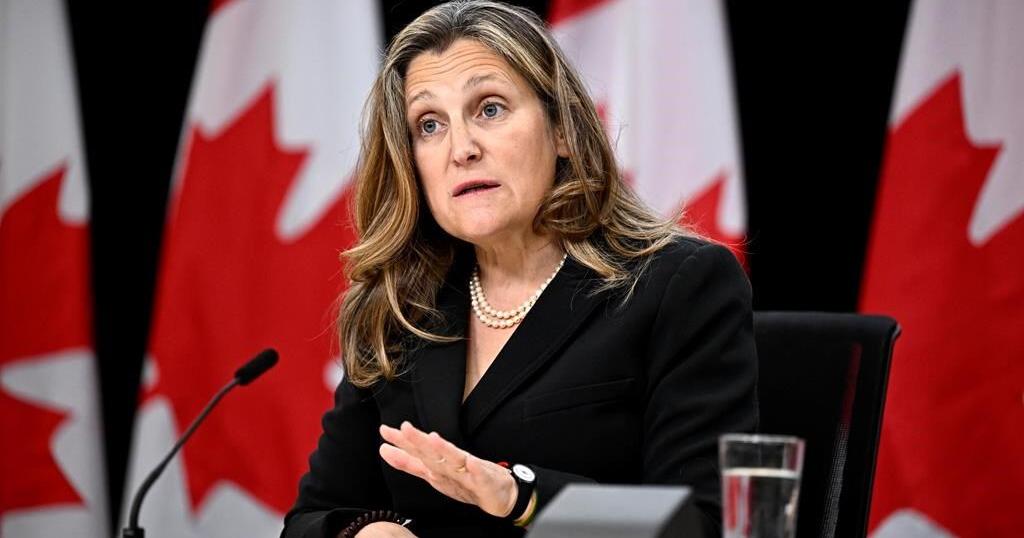OTTAWA – Conservative Leader Pierre Poilievre was not allowed to speak in the House of Commons Tuesday as his public feud with Foreign Affairs Minister Mélanie Joly spilled into a second day.
House Speaker Greg Fergus delivered the penalty to Poilievre in the morning, a day after he asked the leader of the opposition to withdraw a remark accusing Joly of pandering to supporters of the terrorist organization Hamas.
Poilievre made the comment during question period Monday, the one year anniversary of the Oct. 7 Hamas attack on Israel, after he asked the Liberals to condemn “genocidal chants from hateful mobs on our streets.”
“Our Jewish friends and neighbours have been doubly victimized as antisemitic mobs take to the streets shouting, ‘from Palestine to Lebanon, Israel will soon be gone’ and ‘there is only one solution: intifada, revolution,'” Poilievre said.
Joly responded by naming the seven Canadians killed in the Hamas attack on Israel on Oct. 7, 2023 and saying the government stands with the Jewish people.
Poilievre said she hadn’t actually condemned antisemitism in Canada in her response and accused her of refusing to do to in a bid to score political points for what he called her desire to run for the Liberal leadership.
“She continues to pander to Hamas supporters and the Liberal party as part of her leadership campaign rather than doing her job,” he said.
Joly accused Poilievre of “gaslighting” and playing politics on a day that was meant to respect the victims of Oct. 7.
“Clearly, the guy’s unfit to become a prime minister because Canadians deserve way better,” she said, asking him to apologize.
All MPs, including the Liberals, supported a Conservative motion in the House Monday condemning Hamas and antisemitism in Canada.
At the end of question period Fergus asked Poilievre to withdraw his comment about Joly, noting he had asked another MP to withdraw after he made a similar comment about Poilievre “pandering to a regime I think most of us would find odious.”
That MP, Yvan Baker, has not withdrawn the remark and hasn’t been allowed to speak in the House since March.
Fergus initially denied the Liberal request to keep Poilievre from speaking until he withdrew, but changed his mind Tuesday and issued the one-day ban. Fergus noted this is not Poilievre’s first offence nor is he new to the rules of the decorum in the House.
“Over the last few months, the member refused to heed decisions by the chair on non-parliamentary remarks during question periods on two occasions,” Fergus said.
Poilievre received a warning the first time; the second time the Conservatives had questions removed from their daily allotment.
“Yesterday’s events represent a third occasion,” Fergus said. “The opposition (leader) should withdraw his comments made yesterday during question period … if he is not willing to do so, the chair will not recognize him for the remainder of today.”
Fergus also said Tuesday that Baker’s punishment would end Wednesday.
Poilievre has not withdrawn the remark and did not appear in the House of Commons on Tuesday.
He held a news conference in the foyer outside the House of Commons before question period, accusing Prime Minister Justin Trudeau and the Liberals of being at fault for the rise in antisemitism in Canada in the last year.
Poilievre said antisemitism began to increase in Canada before Oct. 7, 2023, and that there have been previous conflicts in the Middle East that did not lead to similar problems in Canada.
Joly appeared in the foyer shortly after Poilievre, saying he is hypocritical and unfit to govern the country.
In a statement, Conservative spokesperson Sebastian Skamski said the Speaker is showing “partisan bias” by trying to censor questions from his party.
Tensions in the House of Commons remained during question period, with members from all parties heckling each other at various points throughout as the Speaker tried to restore order.
The Conservatives asked the Liberals multiple times if they would add Samidoun as a listed terrorist entity.
That group organized a pro-Palestinian rally in Vancouver Monday night, where a masked woman led the crowd to chant “death to Canada, death to the United States and death to Israel,” while others burned Canadian flags.
Conservative MP Melissa Lantsman asked “what the hell it is going to take” for the Liberals to ban the organization.
The Speaker asked her to withdraw “hell” as it is unparliamentary, and she did.
Jennifer O’Connell, parliamentary secretary to the public safety minister, said the government would not follow the Conservatives and “play politics” with the issue.
“When it comes to listing of terrorist entities, the members opposite know full well it is not a political decision,” O’Connell said. “It is based on the national security services of this country.”
“But it’s precisely why the minister had already sent it for an urgent review, understanding that this hate is unacceptable in Canada.”
While O’Connell was answering the question, Lantsman shouted from across the aisle that she should be “ashamed” of herself.
This report by The Canadian Press was first published Oct. 8, 2024.
— With files from Chuck Chiang in Vancouver
























